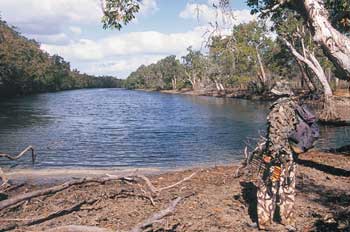Swamp tips
by Bob Hart
Hunter 9
 When hunting swamps for boars, as with any terrain, it is wise to know
the area. If you do not know the area, go with someone who can act as
your guide or at least do not hunt alone. For one thing, swamps have
different bottoms. For instance, some bottoms are fairly solid while
others are covered with a soft mud. The depth of this soft mud can pose
real problems, not to mention the depth of the water, which can also
When hunting swamps for boars, as with any terrain, it is wise to know
the area. If you do not know the area, go with someone who can act as
your guide or at least do not hunt alone. For one thing, swamps have
different bottoms. For instance, some bottoms are fairly solid while
others are covered with a soft mud. The depth of this soft mud can pose
real problems, not to mention the depth of the water, which can also
I was on one property in the Northern Territory that contained a massive swamp that stretched for 11 kilometres by five kilometres. Parts of the swamp had shallow water, while other parts had stretches of deep holes. It was not so much the deep water that concerned us as much as what was living in it - estuarine crocodiles or as some would call them ‘salties’.
I was hunting the area with a guide who knew the area well. At times we were on fairly solid ground but then we would hit stretches of soft mud where we would sink to over our knees. If it were not for the fact that I had a guide, I would have serious reservations for going on any further.
There were times when I wondered when my feet would stop sinking, but I was never in any danger thanks to the guide.
What is one of the most important items you can take on a hunt? Footwear. I have heard of some adventurous souls who hunt in bare feet. Personally I think this is very foolish. In murky swamp water you cannot see the bottom. There could be sharp objects lying just under the mud such as jagged sticks or broken mussel shells that could inflict painful injury to the unwary hunter.
Light, soft slipper-like footwear that is so effective in dry areas, has no place in the swamps. The main shortcoming of this footwear is they come off very easily when a foot is extracted from a soft muddy bottom. Have you ever tried to find a shoe that is a metre under mud and water?
I used to wear lace-up sand shoes, and although they didn’t come off, they allowed mud and vegetation to seep in. At the end of the day my shoes were a horrific mess and my socks were so vile they were discarded at the end of the hunt. A fellow hunter recently advised me to use neoprene diving boots when hunting in these conditions. On my last hunt I gave it a try and pleasantly discovered they worked very well. The snug zip-up boots didn’t let in any foreign matter, and were a snap to clean. I suggest any hunter planning to hunt swamps seriously consider using this type of footwear.
When I am in the tropics, I wear long-sleeved shirts and long pants. This protects me from the harmful sun and the long pants have another useful purpose - protection from revolting leeches, which live in the tropical waters.
Not all swamps are one watery bog. Some have beautiful islands that harbour exotic palms and bushes, while others have low-lying islands of grasses and short shrubs. I always enjoy reaching one of these oases when I slog through a swamp.
When I hunt a swamp, I am usually gone a full or at least half the day. I always carry a small to medium backpack. To make it 100 per cent waterproof I insert a plastic bag as a liner. If I happen to tumble in the water, my expensive Nikon will hopefully be spared. I also carry a two-litre water container, which fits neatly in my backpack.
Separate plastic zip-up bags contain food and a basic medical kit. The medical kit is very simple and contains a couple of pressure bandages for snakebite or fractures, small bandages and Betadine for small cuts and abrasions, and a painkiller (I prefer any Ibuprofen, which reduce inflammation as well).
Hunting boars is a real challenge and many things can go wrong during the hunt. It is best to be prepared rather than spend your hunting trip regretting you left your home.
